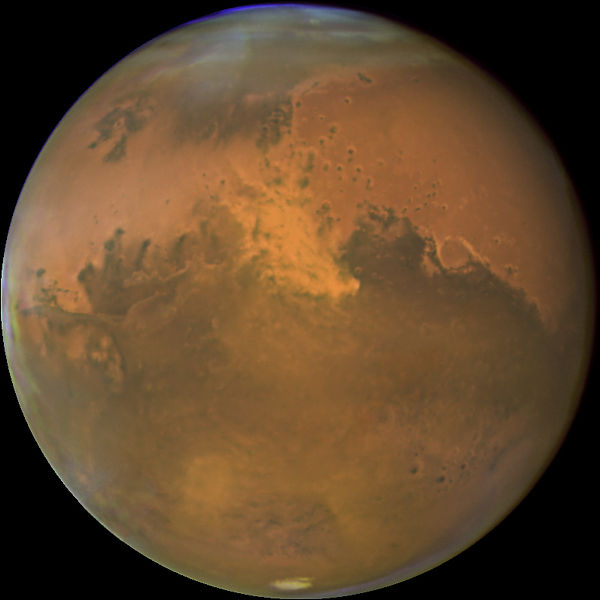File:2005-1103mars-full.jpg

File originale (800 × 800 pixel, dimensione del file: 232 KB, tipo MIME: image/jpeg)
Questo file proviene da Wikimedia Commons e può essere utilizzato da altri progetti. Di seguito viene mostrata la descrizione presente nella pagina di descrizione del file.
Dettagli
NASA's Hubble Space Telescope snapped this picture of Mars on October 28, 2005, within a day of its closest approach to Earth on the night of October 29. Hubble astronomers were also excited to have captured a regional dust storm on Mars that has been growing and evolving over the past few weeks. The dust storm, which is nearly in the middle of the planet in this Hubble view is about 930 miles (1500 km) long measured diagonally, which is about the size of the states of Texas, Oklahoma, and New Mexico combined. No wonder amateur astronomers with even modest-sized telescopes have been able to keep an eye on this storm. The smallest resolvable features in the image (small craters and wind streaks) are the size of a large city, about 12 miles (20 km) across. The occurrence of the dust storm is in close proximity to the NASA Mars Exploration Rover Opportunity's landing site in Sinus Meridiani. Dust in the atmosphere could block some of the sunlight needed to keep the rover operating at full power.
On October 29/30, 2005, Mars and Earth reached the point in their orbits where the two planets were the closest they have been since August of 2003. The red planet, named after the Roman god of war, won't be this close again to Earth until 2018. At the 2005 closest approach Mars was at a distance of 43 million miles (69 million km), comparatively a stone's throw across the solar system. Mars goes through a 26-month cycle where its distance from Earth changes. At times when the distance is smallest between the two planets, Mars appears brighter in the sky and larger through telescopes for Earth viewers.
This image of 2005 Mars closest approach was taken with Hubble's Advanced Camera for Surveys. Different filters show blue, green, and red (250, 502 and 658 nanometer wavelengths). North is at the top of the image. Mars is now in its warmest months, closest to the Sun in its orbit, resulting in a smaller than normal south polar ice cap which has largely sublimated with the approaching summer.
The large regional dust storm appears as the brighter, redder cloudy region in the middle of the planet's disk. This storm has been churning in the planet's equatorial regions for several weeks now, and it is likely responsible for the reddish, dusty haze and other dust clouds seen across this hemisphere of the planet in views from Hubble, ground based telescopes, and the NASA and ESA spacecraft studying Mars from orbit. Bluish water-ice clouds can also be seen along the limbs and in the north (winter) polar region at the top of the image.
Credit: NASA, ESA, The Hubble Heritage Team (STScI/AURA), J. Bell (Cornell University) and M. Wolff (Space Science Institute) Image Type: AstronomicalSTScI-PRC2005-34a
Mars near its 2005 opposition
Source
- http://imgsrc.hubblesite.org/hu/db/2005/34/images/a/formats/large_web.jpg copia archiviata at the Wayback Machine
- http://hubblesite.org/newscenter/newsdesk/archive/releases/2005/34/image/a
Licenza
| Public domainPublic domainfalsefalse |
| This file is in the public domain because it was created by NASA and ESA. NASA Hubble material (and ESA Hubble material prior to 2009) is copyright-free and may be freely used as in the public domain without fee, on the condition that only NASA, STScI, and/or ESA is credited as the source of the material. This license does not apply if ESA material created after 2008 or source material from other organizations is in use. The material was created for NASA by Space Telescope Science Institute under Contract NAS5-26555, or for ESA by the Hubble European Space Agency Information Centre. Copyright statement at hubblesite.org or 2008 copyright statement at spacetelescope.org. For material created by the European Space Agency on the spacetelescope.org site since 2009, use the {{ESA-Hubble}} tag. |
External Links
Didascalie
Elementi ritratti in questo file
raffigura
image/jpeg
e7a8e3c307ba00cd8a68a1e0f468f6238b193d95
237 965 byte
800 pixel
800 pixel
Cronologia del file
Fare clic su un gruppo data/ora per vedere il file come si presentava nel momento indicato.
| Data/Ora | Miniatura | Dimensioni | Utente | Commento | |
|---|---|---|---|---|---|
| attuale | 18:52, 19 giu 2009 |  | 800 × 800 (232 KB) | wikimediacommons>Tryphon | Higher resolution. |
Utilizzo del file
La seguente pagina usa questo file:
